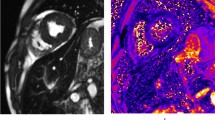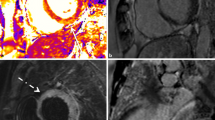Abstract
Cardiac magnetic resonance (CMR) imaging is an effective method for noninvasively imaging the heart which in the last two decades impressively enhanced spatial and temporal resolution and imaging speed, broadening its spectrum of applications in cardiovascular disease. CMR imaging techniques are designed to noninvasively assess cardiovascular morphology, ventricular function, myocardial perfusion, tissue characterization, flow quantification and coronary artery disease. These intrinsic features yield CMR suitable for diagnosis, follow-up and longitudinal monitoring after treatment of cardiovascular diseases. The aim of this paper is to review the technical basis of CMR, from cardiac imaging planes to cardiac imaging sequences.














Similar content being viewed by others
References
Di Cesare E, Cademartiri F, Carbone I et al (2013) Indicazioni cliniche per l’utilizzo della cardio RM. A cura del Gruppo di lavoro della Sezione di Cardio-Radiologia della SIRM [Clinical indications for the use of cardiac MRI. By the SIRM Study Group on Cardiac Imaging]. La Radiologia Medica 118(5):752–798. https://doi.org/10.1007/s11547-012-0899-2
Reeder SB, Faranesh AZ (2000) Ultrafast pulse sequence techniques for cardiac magnetic resonance imaging. Top Magn Reson Imaging TMRI 11(6):312–330. https://doi.org/10.1097/00002142-200012000-00002
Lanzer P, Barta C, Botvinick EH et al (1985) ECG-synchronised cardiac MR imaging: method and evaluation. Radiology 155:681–686. https://doi.org/10.1148/radiology.155.3.4001369
Dinsmore RE, Wismer GL, Levine RA et al (1984) MRI of the heart. Positioning and gradient angle selection for optimal imaging plane. AJR Am J Roentgenol 143:1135–1142. https://doi.org/10.2214/ajr.143.6.1135
Buser PT, Auffermann W, Holt WW et al (1989) Noninvasive evaluation of global left ventricular function with cine NMR. J Am Coll Cardiol 13:1294–1300. https://doi.org/10.1016/0735-1097(89)90304-5
Hennig J, Naureth A, Friedburg H (1986) RARE imaging: a fast imaging method for clinical MR. Magn Reson Med 3:823–833. https://doi.org/10.1002/mrm.1910030602
Einstein S, Outwater E, Kressel HY (1992) First principles of fast spin echo. Magn Reson Q 8(4):199–244
Simonetti OP, Finn JP, White RD et al (1996) “Black Blood” T2-weighted inversion recovery MR imaging of the heart. Radiology 199:49–57. https://doi.org/10.1148/radiology.199.1.8633172
Edelman RR, Chien D, Kim D (1991) Fast selective black blood MR imaging. Radiology 181:655–660. https://doi.org/10.1148/radiology.181.3.1947077
Francone M, Carbone I, Agati L et al (2011) Utility of T2-weighted short-tau inversion recovery (STIR) sequences in cardiac MRI: an overview of clinical applications in ischaemic and non-ischaemic heart disease. La Radiologia Medica 116(1):32–46. https://doi.org/10.1007/s11547-010-0594-0
Iacucci I, Carbone I, Cannavale G et al (2013) Myocardial oedema as the sole marker of acute injury in Takotsubo cardiomyopathy: a cardiovascular magnetic resonance (CMR) study. La Radiologia Medica 118(8):1309–1323. https://doi.org/10.1007/s11547-013-0931-1
Bieri O, Klaus Scheffler K (2013) Fundamentals of balanced steady state free precession MRI. J Magn Reson Imaging 38:2–11. https://doi.org/10.1002/jmri.24163
Benjelloun H, Cranney GB, Kirk KA et al (1991) Interstudy reproducibility of biplane cine nuclear magnetic resonance measurements of left ventricular function. Am J Cardiol 67(16):1413–1420. https://doi.org/10.1016/0002-9149(91)90473-X
Pattynama PM, Lamb HJ, Van der Velde EA et al (1995) Reproducibility of MRI-derived measurements of right ventricular volumes and myocardial mass. Magn Reson Imaging 13(1):53–63. https://doi.org/10.1016/0730-725x(94)00076-f
Corrado D, van Tintelen PJ, McKenna WJ et al (2020) Arrhythmogenic right ventricular cardiomyopathy: evaluation of the current diagnostic criteria and differential diagnosis. Eur Heart J 41(14):1414–1429. https://doi.org/10.1093/eurheartj/ehz669
Schulz-Menger J, Bluemke DA, Bremerich J et al (2020) Standardized image interpretation and post-processing in cardiovascular magnetic resonance—2020 update. J Cardiovasc Magn Reson 22:19. https://doi.org/10.1186/1532-429X-15-35
Schuster A, Hor KN, Kowallick JT, Beerbaum P et al (2016) Cardiovascular magnetic resonance myocardial feature tracking: concepts and clinical applications. Circ Cardiovasc Imaging 9(4):e004077. https://doi.org/10.1161/CIRCIMAGING.115.004077
Scatteia A, Baritussio A, Bucciarelli-Ducci C (2017) Strain imaging using cardiac magnetic resonance. Heart Fail Rev 22(4):465–476. https://doi.org/10.1007/s10741-017-9621-8
Romano S, Romer B, Evans K et al (2020) Prognostic implications of blunted feature-tracking global longitudinal strain during vasodilator cardiovascular magnetic resonance stress imaging. JACC Cardiovasc Imaging. 13(1 Pt 1):58–65. https://doi.org/10.1016/j.jcmg.2019.03.002
Sørensen TS, Körperich H, Greil GF et al (2004) Operator-independent isotropic three-dimensional magnetic resonance imaging for morphology in congenital heart disease: a validation study. Circulation 110(2):163–169. https://doi.org/10.1161/01.CIR.0000134282.35183.AD
Sørensen TS, Beerbaum P, Körperich H, Pedersen EM (2005) Three-dimensional, isotropic MRI: a unified approach to quantification and visualization in congenital heart disease. Int J Cardiovasc Imaging 21(2–3):283–292. https://doi.org/10.1007/s10554-004-4018-x
Ruehm SG, Nanz D, Baumann A et al (2001) 3D contrast-enhanced MR angiography of the run-off vessels: value of image subtraction. J Magn Reson Imaging JMRI 13(3):402–411. https://doi.org/10.1002/jmri.1058
Earls JP, Rofsky NM, DeCorato DR et al (1996) Breath-hold single-dose gadolinium-enhanced three-dimensional MR aortography: usefulness of a timing examination and MR power injector. Radiology 201(3):705–710. https://doi.org/10.1148/radiology.201.3.8939219
Riederer SJ, Bernstein MA, Breen JF et al (2000) Three-dimensional contrast-enhanced MR angiography with real-time fluoroscopic triggering: design specifications and technical reliability in 330 patient studies. Radiology 215(2):584–593. https://doi.org/10.1148/radiology.215.2.r00ma21584
Wilman AH, Riederer SJ (1997) Performance of an elliptical centric view order for signal enhancement and motion artifact suppression in breath-hold three-dimensional gradient echo imaging. Magn Reson Med 38(5):793–802. https://doi.org/10.1002/mrm.1910380516
Kalb B, Sharma P, Tigges S, Ray GL et al (2012) MR imaging of pulmonary embolism: diagnostic accuracy of contrast-enhanced 3D MR pulmonary angiography, contrast-enhanced low-flip angle 3D GRE, and nonenhanced free-induction FISP sequences. Radiology 263(1):271–278. https://doi.org/10.1148/radiol.12110224
Pryds K, Larsen AH, Hansen MS et al (2019) Myocardial strain assessed by feature tracking cardiac magnetic resonance in patients with a variety of cardiovascular diseases—a comparison with echocardiography. Sci Rep 9(1):11296. https://doi.org/10.1038/s41598-019-47775-4
Nayak KS, Nielsen J, Bernstein MA et al (2015) Cardiovascular magnetic resonance phase contrast imaging. J Cardiovasc Magn Reson 17:71. https://doi.org/10.1186/s12968-015-0172-7
Gatehouse PD, Keegan J, Crowe LA et al (2005) Applications of phase-contrast flow and velocity imaging in cardiovascular MRI. Eur Radiol 15:2172–2184
Kupfahl C, Honold M, Meinhardt G et al (2004) Evaluation of aortic stenosis by cardiovascular magnetic resonance imaging: comparison with established routine clinical techniques. Heart 90(8):893–901. https://doi.org/10.1136/hrt.2003.022376
Di Leo G, D’Angelo ID, Alì M et al (2017) Intra- and inter-reader reproducibility of blood flow measurements on the ascending aorta and pulmonary artery using cardiac magnetic resonance. La Radiologia Medica 122(3):179–185. https://doi.org/10.1007/s11547-016-0706-6
Dyverfeldt P, Bissell M, Barker AJ et al (2015) 4D flow cardiovascular magnetic resonance consensus statement. J Cardiovasc Magn Reson 17:72. https://doi.org/10.1186/s12968-015-0174-5
Hope MD, Hope TA, Meadows AK, Ordovas KG et al (2010) Bicuspid aortic valve: four-dimensional MR evaluation of ascending aortic systolic flow patterns. Radiology 255:53–61. https://doi.org/10.1148/radiol.09091437
Dyverfeldt P, Hope MD, Tseng EE, Saloner D (2013) Magnetic resonance measurement of turbulent kinetic energy for the estimation of irreversible pressure loss in aortic stenosis. JACC Cardiovasc Imaging. 6:64–71. https://doi.org/10.1016/j.jcmg.2012.07.017
Higgins CB, De Roos A (2003) Cardiovascular MRI and MRA. Lippincott Williams and Wilkins, Philadelphia
Luetkens JA, Homsi R, Sprinkart AM et al (2016) Incremental value of quantitative CMR including parametric mapping for the diagnosis of acute myocarditis. Eur Heart J Cardiovasc Imaging 17(2):154–161. https://doi.org/10.1093/ehjci/jev246
Kim RJ, Shah DJ, Judd RM (2003) How we perform delayed enhancement imaging. J Cardiovasc Magn Reson Off J Soc Cardiovasc Magn Reson 5(3):505–514. https://doi.org/10.1081/jcmr-120022267
Muehlberg F, Arnhold K, Fritschi S et al (2018) Comparison of fast multi-slice and standard segmented techniques for detection of late gadolinium enhancement in ischemic and non-ischemic cardiomyopathy—a prospective clinical cardiovascular magnetic resonance trial. J Cardiovasc Magn Reson Off J Soc Cardiovasc Magn Reson 20(1):13. https://doi.org/10.1186/s12968-018-0434-2
Bratis K, Henningsson M, Grigoratos C et al (2017) Image-navigated 3-dimensional late gadolinium enhancement cardiovascular magnetic resonance imaging: feasibility and initial clinical results. J Cardiovasc Magn Reson Off J Soc Cardiovasc Magn Reson 19(1):97. https://doi.org/10.1186/s12968-017-0418-7
McCrohon JA, Moon JC, Prasad SK et al (2003) Differentiation of heart failure related to dilated cardiomyopathy and coronary artery disease using gadolinium-enhanced cardiovascular magnetic resonance. Circulation 108(1):54–59. https://doi.org/10.1161/01.CIR.0000078641.19365.4C
Moon JC, McKenna WJ, McCrohon JA et al (2003) Toward clinical risk assessment in hypertrophic cardiomyopathy with gadolinium cardiovascular magnetic resonance. J Am Coll Cardiol 41(9):1561–1567. https://doi.org/10.1016/s0735-1097(03)00189-x
Sen-Chowdhry S, Syrris P, Prasad SK et al (2008) Left-dominant arrhythmogenic cardiomyopathy: an under-recognized clinical entity. J Am Coll Cardiol 52(25):2175–2187. https://doi.org/10.1016/j.jacc.2008.09.019
Yan AT, Shayne AJ, Brown KA et al (2006) Characterization of the peri-infarct zone by contrast-enhanced cardiac magnetic resonance imaging is a powerful predictor of post-myocardial infarction mortality. Circulation 114(1):32–39. https://doi.org/10.1161/CIRCULATIONAHA.106.613414
Halliday BP, Gulati A, Ali A et al (2017) Association between midwall late gadolinium enhancement and sudden cardiac death in patients with dilated cardiomyopathy and mild and moderate left ventricular systolic dysfunction. Circulation 135(22):2106–2115. https://doi.org/10.1161/CIRCULATIONAHA.116.026910
Vassiliou VS, Perperoglou A, Raphael C et al (2017) Midwall fibrosis and 5-year outcome in moderate and severe aortic stenosis. J Am Coll Cardiol 69(13):1755–1756. https://doi.org/10.1016/j.jacc.2017.01.034
Vergara GR, Marrouche NF (2011) Tailored management of atrial fibrillation using a LGE-MRI based model: from the clinic to the electrophysiology laboratory. J Cardiovasc Electrophysiol 22(4):481–487. https://doi.org/10.1111/j.1540-8167.2010.01941.x
Goldfarb JW (2008) Fat-water separated delayed hyperenhanced myocardial infarct imaging. Magn Reson Med 60(3):503–509. https://doi.org/10.1002/mrm.21685
Puntmann VO, Voigt T, Chen Z et al (2013) Native T1 mapping in differentiation of normal myocardium from diffuse disease in hypertrophic and dilated cardiomyopathy. JACC Cardiovasc Imaging 6(4):475–484. https://doi.org/10.1016/j.jcmg.2012.08.019
Messroghli DR, Moon JC, Ferreira VM, Grosse-Wortmann L, He T, Kellman P, Mascherbauer J, Nezafat R, Salerno M et al (2017) Clinical recommendations for cardiovascular magnetic resonance mapping of T1, T2, T2* and extracellular volume: a consensus statement by the Society for Cardiovascular Magnetic Resonance (SCMR) endorsed by the European Association for Cardiovascular Imaging (EACVI). J Cardiovasc Magn Reson Off J Soc Cardiovasc Magn Reson 19(1):75. https://doi.org/10.1186/s12968-017-0389-8
Messroghli DR, Radjenovic A, Kozerke S et al (2004) Modified Look-Locker inversion recovery (MOLLI) for high-resolution T1 mapping of the heart. Magn Reson Med 52(1):141–146. https://doi.org/10.1002/mrm.20110
Piechnik SK, Ferreira VM, Dall’Armellina E et al (2010) Shortened Modified Look-Locker Inversion recovery (ShMOLLI) for clinical myocardial T1-mapping at 1.5 and 3 T within a 9 heartbeat breathhold. J Cardiovasc Magn Reson Off J o Soc Cardiovasc Magn Reson 12(1):69. https://doi.org/10.1186/1532-429X-12-69
Baggiano A, Boldrini M, Martinez-Naharro A et al (2020) Noncontrast magnetic resonance for the diagnosis of cardiac amyloidosis. JACC Cardiovasc Imaging 13(1 Pt 1):69–80. https://doi.org/10.1016/j.jcmg.2019.03.026
Sado DM, White SK, Piechnik SK et al (2013) Identification and assessment of Anderson–Fabry disease by cardiovascular magnetic resonance noncontrast myocardial T1 mapping. Circ Cardiovasc Imaging 6(3):392–398. https://doi.org/10.1161/CIRCIMAGING.112.000070
Hinojar R, Varma N, Child N et al (2015) T1 mapping in discrimination of hypertrophic phenotypes: hypertensive heart disease and hypertrophic cardiomyopathy: findings from the international T1 multicenter cardiovascular magnetic resonance study. Circ Cardiovasc Imaging 8(12):e003285. https://doi.org/10.1161/CIRCIMAGING.115.003285
Flett AS, Sado DM, Quarta G et al (2012) Diffuse myocardial fibrosis in severe aortic stenosis: an equilibrium contrast cardiovascular magnetic resonance study. Eur Heart J Cardiovasc Imaging 13(10):819–826. https://doi.org/10.1093/ehjci/jes102
Miller CA, Naish JH, Bishop P et al (2013) Comprehensive validation of cardiovascular magnetic resonance techniques for the assessment of myocardial extracellular volume. Circ Cardiovasc Imaging 6(3):373–383. https://doi.org/10.1161/CIRCIMAGING.112.000192
Ferreira VM, Piechnik SK, Dall’Armellina E et al (2012) Non-contrast T1-mapping detects acute myocardial edema with high diagnostic accuracy: a comparison to T2-weighted cardiovascular magnetic resonance. J Cardiovasc Magn Reson Off J Soc Cardiovasc Magn Reson 14(1):42. https://doi.org/10.1186/1532-429X-14-42
Bulluck H, White SK, Rosmini S et al (2015) T1 mapping and T2 mapping at 3T for quantifying the area-at-risk in reperfused STEMI patients. J Cardiovasc Magn Reson Off J Soc Cardiovasc Magn Reson 17(1):73. https://doi.org/10.1186/s12968-015-0173-6
Hosch W, Bock M, Libicher M et al (2007) MR-relaxometry of myocardial tissue: significant elevation of T1 and T2 relaxation times in cardiac amyloidosis. Investig Radiol 42(9):636–642. https://doi.org/10.1097/RLI.0b013e318059e02
Greenwood JP, Maredia N, Younger JF et al (2012) Cardiovascular magnetic resonance and single-photon emission computed tomography for diagnosis of coronary heart disease (CE-MARC): a prospective trial. Lancet (London, England) 379(9814):453–460. https://doi.org/10.1016/S0140-6736(11)61335-4
Laspas F, Pipikos T, Karatzis E et al (2020) Cardiac magnetic resonance versus single-photon emission computed tomography for detecting coronary artery disease and myocardial ischemia: comparison with coronary angiography. Diagnostics (Basel, Switzerland) 10(4):190. https://doi.org/10.3390/diagnostics10040190
Marano R, Natale L, Chiribiri A et al (2015) Cardiac MR perfusion imaging: where we are. La Radiologia Medica 120(2):190–205. https://doi.org/10.1007/s11547-014-0435-7
Funding
Financial support for this study was not provided.
Author information
Authors and Affiliations
Corresponding author
Ethics declarations
Conflict of interest
None of the authors has a potential conflict of interest.
Ethical standards
Due to the nature of the paper (review article), non-research with human participants or animals has been made and, consequently, informed consent is not applicable.
Additional information
Publisher's Note
Springer Nature remains neutral with regard to jurisdictional claims in published maps and institutional affiliations.
Rights and permissions
About this article
Cite this article
Russo, V., Lovato, L. & Ligabue, G. Cardiac MRI: technical basis. Radiol med 125, 1040–1055 (2020). https://doi.org/10.1007/s11547-020-01282-z
Received:
Accepted:
Published:
Issue Date:
DOI: https://doi.org/10.1007/s11547-020-01282-z




